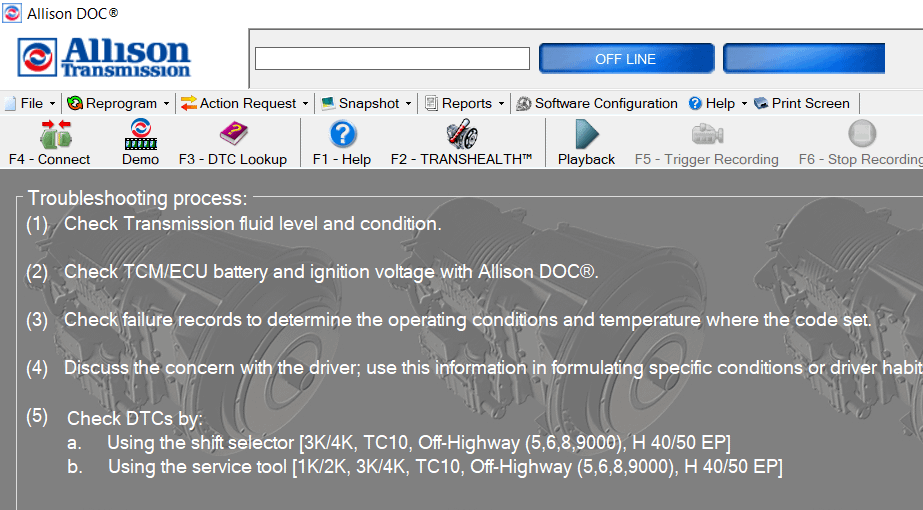Allison Transmission fault code list provides precise information about the various fault codes that may occur in Allison Transmissions. This list is essential for diagnosing and troubleshooting transmission issues effectively.
Understanding these codes can help technicians identify the specific problem and take appropriate action to resolve it. The Allison Transmission fault code list is a comprehensive resource that plays a crucial role in maintaining and repairing Allison Transmissions. It covers a wide range of fault codes, including those related to shift solenoid malfunctions, sensor failures, electrical issues, and more.
By referring to this list, technicians can quickly identify the code displayed on the transmission control module and then refer to the relevant section for detailed information on the possible causes and recommended actions to fix the problem. This not only saves time but also ensures accurate diagnosis, enabling technicians to address transmission issues promptly and effectively.


Credit: dieseldiagnosticequipment.com
- Common Allison Transmission Fault Codes
- How To Interpret Allison Transmission Fault Codes
- Troubleshooting Steps For Allison Transmission Fault Codes
- Common Solutions For Allison Transmission Fault Codes
- Preventive Maintenance To Avoid Transmission Issues
- When To Seek Professional Help
- Frequently Asked Questions For Allison Transmission Fault Code List
- Conclusion
Common Allison Transmission Fault Codes
If you own a vehicle with an Allison transmission, it’s essential to be aware of the potential issues that may arise. Understanding the common fault codes can help you diagnose and address transmission problems quickly.
P0700 – Transmission Control System Malfunction
The P0700 fault code is an indication of a potential issue with the transmission control system. This code is a general transmission-related code that informs you that there may be a problem. When this fault code appears, it is necessary to use a diagnostic scanner to read the additional codes that are stored in the transmission control module to determine the specific issue.
P0562 – System Voltage Low
A low system voltage can cause numerous transmission-related problems, including poor shifting and overall performance. The P0562 fault code indicates that the system voltage has fallen below a specified threshold. This code often appears when there is a battery or alternator issue. To resolve this problem, it is necessary to inspect the battery, alternator, and electrical connections for any signs of damage or corrosion.
P0872 – Transmission Fluid Pressure Sensor / Switch ‘c’ Circuit Low
The P0872 fault code typically indicates a low reading from the transmission fluid pressure sensor or switch ‘C’ circuit. This issue may result from a faulty sensor, a wiring problem, or low transmission fluid level. It is crucial to check the transmission fluid level and inspect the wiring and connector leading to the pressure sensor. Additionally, the sensor itself may need to be replaced if it is found to be faulty.
P0741 – Torque Converter Clutch Circuit Performance Or Stuck Off
The P0741 fault code points to a problem with the torque converter clutch circuit. This code commonly appears when the torque converter is failing to engage or disengage properly. It may be caused by a faulty solenoid or a malfunctioning clutch. If the torque converter clutch circuit is stuck off, it can lead to poor transmission performance, including slipping or overheating. It is advised to have a professional diagnose and repair this issue to prevent further damage to the transmission.
P0894 – Transmission Component Slipping
The P0894 fault code indicates that one or more components in the transmission are slipping. Slippage can occur due to a variety of reasons, such as worn clutch plates, low fluid level, or a malfunctioning solenoid. If this fault code appears, it is important to have the transmission inspected by a qualified technician. Ignoring this issue can lead to further transmission damage and costly repairs.
How To Interpret Allison Transmission Fault Codes
Understanding and interpreting the fault codes generated by your Allison transmission can be a crucial part of ensuring the smooth operation of your vehicle. These fault codes provide valuable information about any potential issues or malfunctions within the transmission. In this section, we will discuss how to effectively interpret Allison transmission fault codes, providing you with the knowledge you need to diagnose and address any problems that may arise during operation.
Using Diagnostic Tools
When it comes to interpreting Allison transmission fault codes, the first step is to have the right diagnostic tools at your disposal. These tools are designed to read and interpret the fault codes generated by the transmission, allowing you to pinpoint the specific issue that needs to be addressed. There are various diagnostic tools available in the market, each with its own set of features and capabilities. It’s important to choose a tool that is compatible with your Allison transmission model and provides comprehensive fault code information.
In addition to the diagnostic tool, you will need a laptop or computer with the necessary software to connect to the transmission and retrieve the fault codes. Once connected, the diagnostic tool will communicate with the transmission control module, retrieving the fault codes and displaying them on your computer screen.
Deciphering Code Numbers
After retrieving the fault codes, the next step is deciphering the code numbers. Each fault code consists of a combination of letters and numbers, each representing a specific fault. For example, a code like P0562 indicates a voltage-related fault, while a code like P0730 suggests an issue with the transmission gear ratio.
To effectively interpret these code numbers, it’s important to refer to the Allison transmission fault code list. This comprehensive list provides detailed information about each fault code, including its description, possible causes, and recommended solutions. By cross-referencing the fault code with the list, you can gain a better understanding of the specific issue and take the necessary steps to resolve it.
Please see the table below for some examples of common Allison transmission fault codes:
| Fault Code | Description | Possible Causes | Recommended Action |
|---|---|---|---|
| P0562 | Voltage-related fault | Weak battery, faulty alternator | Check battery and alternator connections; replace faulty components |
| P0730 | Transmission gear ratio issue | Worn clutch, faulty solenoid | Inspect clutch and solenoid; replace if necessary |
By referring to the Allison transmission fault code list and understanding the meaning behind the code numbers, you can effectively diagnose and resolve any issues with your transmission. It’s important to address these fault codes promptly to prevent further damage and ensure the reliable performance of your vehicle.
Troubleshooting Steps For Allison Transmission Fault Codes
When facing issues with your Allison transmission, it is essential to follow proper troubleshooting steps to diagnose and resolve fault codes efficiently. Below are key actions you can take to troubleshoot Allison transmission fault codes.
Checking Fluid Levels
- Ensure transmission fluid is at the correct level and in good condition.
- Refer to the manufacturer’s guidelines for proper fluid level checks.
- Top up or replace fluid if low or contaminated.
Inspecting Electrical Connections
- Examine wiring harnesses and connectors for any damage or corrosion.
- Securely reconnect any loose connections.
- Check for short circuits and address promptly.
Testing Sensors And Switches
- Verify proper functioning of sensors using diagnostic tools.
- Calibrate switches to ensure accurate transmission performance.
- Replace faulty sensors or switches as needed.

Credit: www.amazon.com
Common Solutions For Allison Transmission Fault Codes
When your Allison transmission system throws a fault code, finding the root cause of the issue and implementing a fix is crucial to ensure smooth operations. Common solutions for Allison transmission fault codes can include replacing faulty sensors, repairing wiring issues, and resetting the transmission control module. Below, we’ll delve into each solution to help you understand how to effectively address these faults.
Replacing Faulty Sensors
If you suspect that a faulty sensor is the culprit behind an Allison transmission fault code, taking the following steps can help resolve the issue:
- Locate the faulty sensor using diagnostic equipment.
- Source a replacement sensor from an authorized supplier.
- Follow manufacturer guidelines to ensure proper installation of the new sensor.
Repairing Wiring Issues
Wiring issues are common sources of transmission fault codes. Here’s how you can address them:
- Conduct a thorough visual inspection of wiring harnesses and connectors.
- Test for continuity and inspect for damage.
- Repair or replace damaged wiring and ensure proper reconnection.
Resetting The Transmission Control Module
If resetting the transmission control module is necessary, follow these steps:
- Locate the transmission control module according to the manufacturer’s specifications.
- Using the proper tools, perform the reset procedure as outlined by the manufacturer.
- Ensure that all parameters and settings are restored to factory defaults.
Preventive Maintenance To Avoid Transmission Issues
Preventive maintenance is crucial to avoiding transmission issues in your vehicle. By adhering to scheduled maintenance and conducting regular checks, you can extend the life of your Allison transmission and avoid costly repairs. Here are the essential preventive maintenance measures to keep your transmission running smoothly.
Regular Fluid Checks And Changes
Maintaining the proper fluid levels and ensuring that the transmission fluid is clean and free of contaminants is vital for the optimal performance of your Allison transmission. Regularly check the transmission fluid level using the dipstick and look for any signs of discoloration or unusual odor. Any discrepancies should be promptly addressed by flushing and replacing the transmission fluid. This will help prevent wear and tear on internal components and extend the lifespan of your transmission. It’s recommended to perform fluid checks and changes as per the manufacturer’s guidelines or every 30,000 miles.
Scheduled Transmission Inspections
Scheduling periodic inspections by a qualified technician is another essential aspect of preventive maintenance. These inspections provide an opportunity to identify potential issues before they escalate. The technician will conduct a thorough examination of the transmission system, including the fluid level and condition, fluid leaks, and overall performance. Any anomalies discovered can be addressed promptly, preventing more extensive damage. It is advisable to adhere to the manufacturer’s recommended inspection schedule, typically every 50,000 miles or at regular service intervals.
When To Seek Professional Help
Complex Fault Codes
Some Allison transmission fault codes can be intricate and require in-depth technical knowledge to decipher.
Limited Diy Experience
If you have minimal experience in troubleshooting vehicle issues, it’s best to consult a professional.

Credit: www.dieselpowerproducts.com
Frequently Asked Questions For Allison Transmission Fault Code List
What Are Common Allison Transmission Fault Codes?
Allison transmission fault codes such as P0700, P0841, and P0871 are commonly seen and can indicate issues with the transmission system. These codes may point to specific problems like fluid pressure, shift solenoids, or communication errors that need immediate attention.
How Do I Troubleshoot Allison Transmission Fault Codes?
To troubleshoot Allison transmission fault codes, start by performing a diagnostic scan to identify the specific code and its underlying issue. Next, check the transmission fluid level, inspect for any visible damage, and test the electrical components for proper function.
Seeking professional help is advised for accurate diagnosis and repairs.
What Are The Consequences Of Ignoring Transmission Fault Codes?
Ignoring Allison transmission fault codes can lead to severe damage to the transmission system, resulting in costly repairs or even transmission failure. By addressing the fault codes promptly, you can prevent further damage, ensure safe operation, and potentially save on repair expenses in the long run.
Conclusion
Understanding Allison Transmission fault codes is crucial for timely diagnostics and repairs. With this comprehensive list, drivers and mechanics can quickly identify issues and take appropriate action. Stay informed and proactive to ensure your transmission system operates smoothly and efficiently.
Empower yourself with knowledge to keep your vehicle on the road.